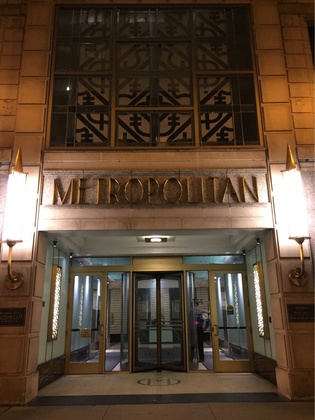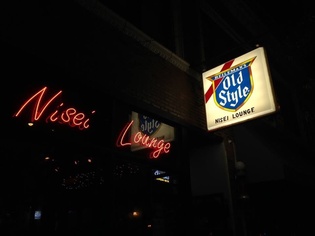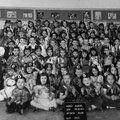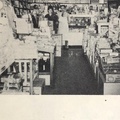With a family of six and a full-time job, researching and writing full-length articles about family and community was becoming exceedingly difficult. However, the thirst to research our Chicago Nikkei community's past and present had not fizzled, as I feel it important to leave these stories for my kids, the Gosei generation, so they know how the greater community's history intersects with that of our post-WWII resettled family. These stories are the whys and hows of our existence.
Instagram, a photo and video sharing service accessible by both web browser and phone app, proved an interesting outlet for someone like me with limited time. With a 2200 character limit to its captions, including spaces, hard returns, and hashtags, telling the story of a someone, someplace, something, or a something that happened to someone someplace in roughly 250-300 words really challenges one to cut the fat. The sparseness of it felt really attractive. Writing is in the editing, as they say.
Windy City Nikkei (@windycitynikkei) on Instagram is positioned as "Bite-sized glimpses of Japanese American Chicago." Portioned hors d'oeuvres to pick at on the run. One reader called it, "amuse-bouche history!" People who have neither the time nor inclination to read longer form stories have expressed appreciation for the accessibility of easy, cut-to-the-chase reading.
Features have included Nikkei related neighborhoods, stores, restaurants, bars, sports, artists, businesspeople, churches, temples, recipes, news clippings, anything that sparks an interest or that I can pull my phone out quick enough to snap a photo of.
For instance, I was once rolling down Wells Street in Chicago’s Old Town neighborhood and came across HONORARY MARION KONISHI WAY on the corner of Schiller. I pulled over, got out, took a picture, got back in, and went on my way. Over the course of the following week, I learned all kinds of things about the late, great Marion Konishi and her restaurant, Kamehachi:
|
Windy City Nikkei Sushi-loving Chicagoans need pay a debt of gratitude to the late Marion Konishi, a pioneer of the city’s sushi scene. |
Even at a 2200 character limit, or perhaps because of a 2200 character limit, stories may take days to weeks to suss out—part-time, of course. During lunchtime at work. While watching the kids at judo. A couple minutes in bed before konking out. Constantly saving drafts in e-mails for ease of access. How do you get to the thick of it, yet write attractively, when you have to cut 3,000 characters out of a first draft and maybe another 1,000 out of the second? It can be frustrating, but really carves out the essentials, what can and can't go into the story, smaller words for larger meaning, and disposing of the accoutrements.
Ultimately, each piece of history in the Windy City Nikkei feed is a glimpse. A peripheral glance. Scanning, out of the corner of your eye, while driving, the boarded-up windows of a long since closed café and remembering a first date you had there in high school. Instantaneous recall through feeling. You may reminisce in full later, but the glimpse took a half-a-second to recall an entire evening of something that may have happened years ago. Natsukashii, ne?
|
Windy City Nikkei “A citizen who is concededly loyal presents no problem of espionage or sabotage. Loyalty is a matter of the heart and mind, not of race, creed, or color. He who is loyal is by definition not a spy or a saboteur. When the power to detain is derived from the power to protect the war effort against espionage and sabotage, detention which has no relationship to that objective is unauthorized.” - Ex Parte Endo / United States Supreme Court / December 18, 1944 |
History portioned to whet the appetite. An invitation to find out more. The essence of flavor minus the full course. A flight of beers. An introduction. Windy City Nikkei is a little taste of this, a morsel of that, up to the reader to make of it what they will and dig deeper if they would. Satisfying are comments such as, “I never knew that,” or “I used to love going there with my family,” or “Thanks for the info, I’m going to check that out!” More satisfying is when a topic sparks someone to share their own story.
It was once asked of me if I considered myself a “rogue historian,” due to my informal and conversational approach to thematically whimsical history. I don’t. I don’t consider myself a historian at all, in an academic sense. What I do is tell stories. The stories I wanted to hear but never did because they hadn’t been told. In a way that I would have liked to have heard them. With sentence fragments and run-ons, the way my Nisei grandmother would talk story at the kitchen table over a coffee and cigarette, the dog snoring at her feet and birds chirping from the back room. While research and accuracy is certainly inherent in the data and fact gathering process, Windy City Nikkei is about engaging our community’s history from an approachable posture, an accessible voice, a welcoming tone.
Please follow us on Instagram, and invite us to follow you. Let’s share our respective communities’ stories together, in 2200 characters or less.
|
Windy City Nikkei Founded in the mid-1940s by Hiroto "Kaunch" Hirabayashi at 1238 N. Clark in the Japanese American enclave of Clark & Division, by the 1950s urban renewal and the shift of the community three miles up Clark Street into the Lakeview neighborhood prompted a move of Nisei Lounge to its current location at 3439 N. Sheffield. |
© 2019 Erik Matsunaga












